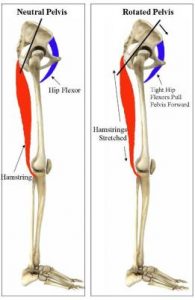From an injury treatment perspective, the tradtional approach to treating hamstring injuries has been to decrease inflammation in the muscle, stretch the hamstrings, and to work on strengthening them. The problem with that method is, if you aren’t addressing issues with the hip flexors, you are missing the boat and the athlete will never fully recover and they will get labeled as having a “chronic” hamstring injury.
 To understand how the hamstrings and hip flexors work together, you need to review the anatomy for a second. The hip flexors originate on the lumbar spine (psoas) and come through the abdominal wall anteriorly to insert on the anterior aspect of ths femur. This allows this muscle to flex the hip. Conversly, the hamstrings originate on the ishial tuberosity on the posterior aspect of the pelvis and insert on the posterior side of the tibia in the lower leg.
To understand how the hamstrings and hip flexors work together, you need to review the anatomy for a second. The hip flexors originate on the lumbar spine (psoas) and come through the abdominal wall anteriorly to insert on the anterior aspect of ths femur. This allows this muscle to flex the hip. Conversly, the hamstrings originate on the ishial tuberosity on the posterior aspect of the pelvis and insert on the posterior side of the tibia in the lower leg.
Because of their location, these muscles work together to help stabilize the pelvis at times, but more often than not, they work as agonists and antagonists to each other. So, as the hip flexors work to flex the hip, the hamstrings work eccentrically to help control this motion and decelerate the movement when needed. The opposite is true when the hamstrings are the primary mover.
Where many athletes run into trouble is when they have a loss of flexibility and mobility in the hip flexors. The majority of today’s athletes have tight hip flexors because of the nature of our life in the U.S. Much our days are spent in a sitting position, leading the hip flexors to a shortened position. It has been said that the hip flexors are the most dysfunctional muscle group in the body. They are the only muscles which can be weak, dominant, and inactive, all at the same time.
 Because we spend much of our days sitting in chairs, the hip flexors have a tendency to become very short and tight. When this happens, the pelvis becomes anteriorly rotated. When this rotation occurs, the hamstring becomes elongated due to the new position of the ischial tuberiosity. Now, you ask the hamstring to fire eccentrically at high speeds during sprinting movements, and they can’t do it because they start all of it under the load of a prestretch.
Because we spend much of our days sitting in chairs, the hip flexors have a tendency to become very short and tight. When this happens, the pelvis becomes anteriorly rotated. When this rotation occurs, the hamstring becomes elongated due to the new position of the ischial tuberiosity. Now, you ask the hamstring to fire eccentrically at high speeds during sprinting movements, and they can’t do it because they start all of it under the load of a prestretch.
So, when you have an athlete with hamstring issues or discomfort, start by stretching the hip flexors. This will reset the pelvis to a more neutral position prior to working with the hamstrings and give them some slack to unload them.
Looking for more help? Schedule a consultation today!
Back to Muscle Interaction
Back to Functional Anatomy
Back to Home


Leave a Reply